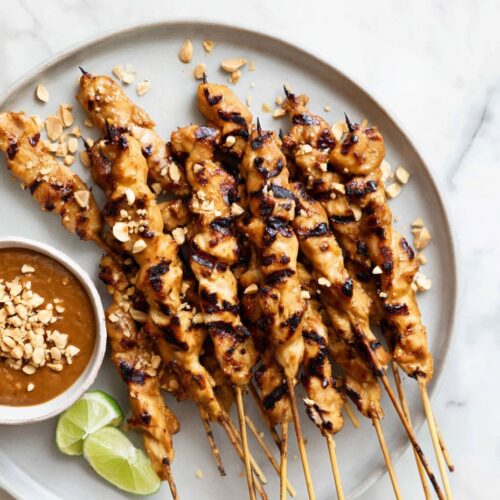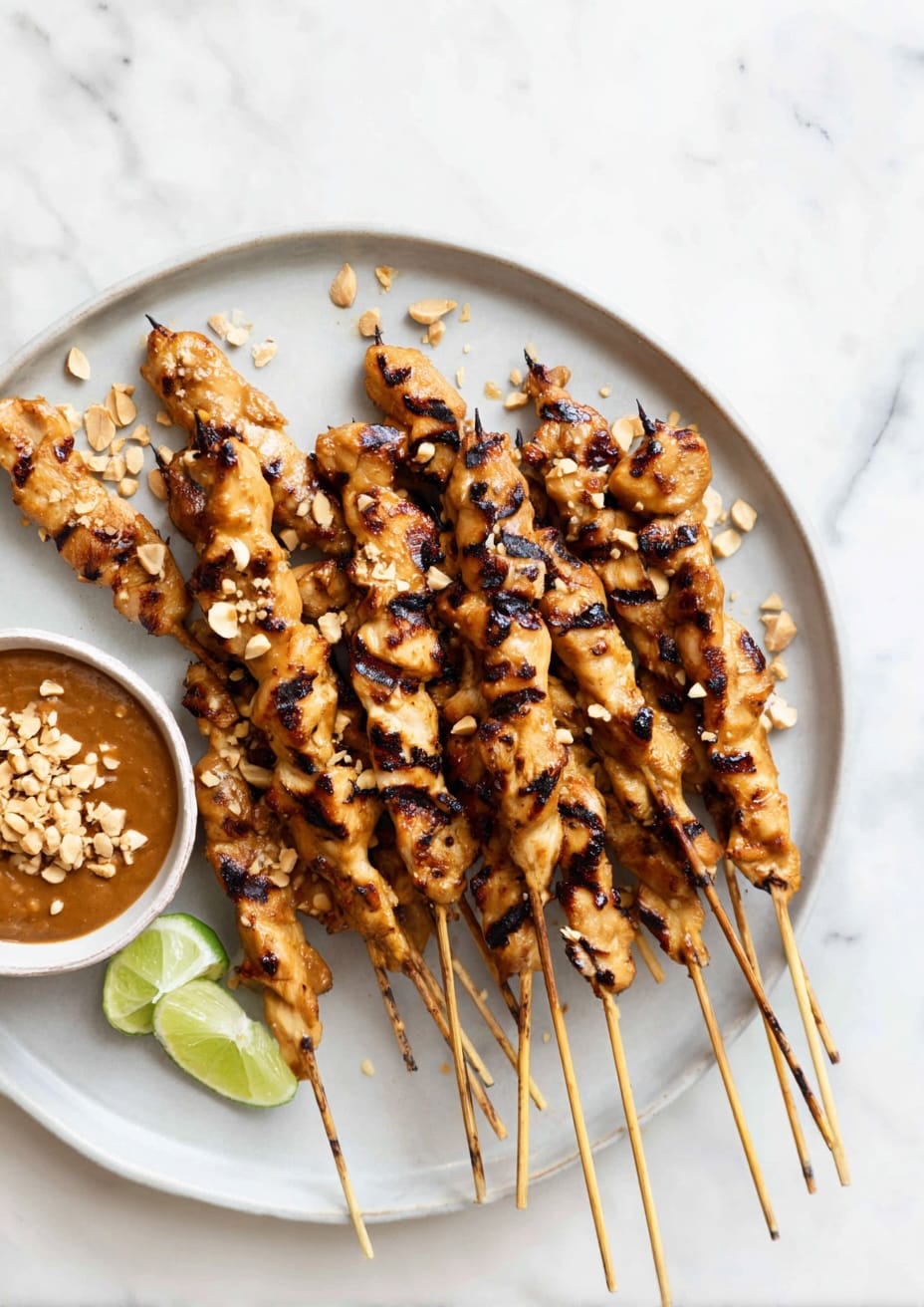When the grill heats up and that smoky, nutty aroma wafts through the kitchen, I know I’m making sate ayam. This Indonesian chicken satay is everything I love about Southeast Asian BBQ: skewered meat, spiced marinades, and a creamy peanut sauce that clings to each bite. It’s the sort of recipe that gets its flavour from patience rather than fuss, and though it looks humble, it tastes like it’s been tended by someone who really cares about their food.
I make this version the way many Indonesian home cooks do, starting with tender chicken thighs and a paste built on garlic, shallots, coriander, and turmeric. The marinade has depth from coconut milk and a touch of tamarind juice for balance. I’ve tested it countless times in my kitchen, and every time it feels like a little escape without leaving the stove.
If you’ve made Sate Madura with sweet soy marinade, this one feels gentler, a little lighter, with more creaminess from coconut milk than sweetness from kecap manis. It also pairs beautifully with the easy satay marinade made with coconut and palm sugar if you prefer something more versatile.
And for those who love to compare flavours, I’d say this recipe sits right between the richness of Balinese pork satay and the spice-forward beef satay with kecap manis and coriander. You can find more inspiration and regional styles in my 10 Indonesian Satay Recipes collection.
The Essence of Indonesian Satay
Chicken satay, or sate ayam, has a way of combining sweet, savoury, and smoky notes in a single bite. What makes it authentic is not just the peanut sauce, but the way the marinade brings together lemongrass, galangal, and palm sugar. Each ingredient is modest, but together they make something worth slowing down for.
Ingredients (serves 4)
- 600 g boneless chicken thighs, cut into 2 cm cubes
- 2 cloves garlic, minced
- 3 shallots, finely chopped
- 1 teaspoon ground coriander
- 1 teaspoon turmeric powder
- 1 teaspoon palm sugar, grated
- 100 ml coconut milk
- 1 tablespoon tamarind juice
- 1 tablespoon kecap manis (sweet soy sauce)
- 1 teaspoon salt
- 2 tablespoons vegetable oil
- 150 g roasted ground peanuts
- 200 ml water
- 1 teaspoon chili paste (adjust to taste)
- ½ teaspoon shrimp paste (optional)
- 1 tablespoon lime juice
For dairy-free diets, this recipe is naturally suitable. To make it gluten-free, ensure your kecap manis and tamarind paste are free from wheat additives.
Ingredient Notes
Chicken thighs hold up beautifully to grilling and stay moist, even if slightly overcooked. Breast meat works too, but the fat in thighs gives a more traditional, juicy texture. Tamarind juice adds gentle acidity that balances the coconut milk’s richness, so avoid skipping it.
Palm sugar is essential for its smoky sweetness. If you can’t find it, dark brown sugar does the job but lacks that caramel edge. The roasted peanuts are best if freshly ground, as they release a natural oil that helps thicken the sauce without extra fat.
Equipment Needed
A small food processor or mortar and pestle makes light work of the spice paste. A charcoal grill gives the best flavour, though a gas grill or a stovetop griddle will work in a pinch. Long bamboo skewers are traditional, but metal ones hold heat better for a quick sear.
A saucepan is handy for simmering the peanut sauce, which thickens beautifully over low heat. I use a silicone brush to coat the skewers with leftover marinade before grilling—it adds extra smokiness once the edges start to char.
Instructions
Combine the garlic, shallots, coriander, turmeric, palm sugar, salt, and vegetable oil into a smooth paste. Mix in the coconut milk, tamarind juice, and kecap manis until the colour deepens to gold. Coat the chicken pieces evenly, cover, and leave to marinate in the fridge for at least three hours or overnight for deeper flavour.
Thread the chicken onto skewers, packing them snugly but not too tightly. Preheat the grill until hot, then cook the skewers over medium-high heat for 3 to 4 minutes on each side, basting with leftover marinade. Turn until the edges are caramelised and lightly charred.
For the sauce, blend roasted peanuts, chili paste, and shrimp paste (if using) with water to form a thick mixture. Simmer gently in a saucepan for five minutes, stirring constantly. Add lime juice and adjust seasoning until balanced. The sauce should coat a spoon and hold its shape.
Serve the satay hot, spooned generously with peanut sauce, and finish with a drizzle of kecap manis if you like a glossier finish.
Satay Grill Techniques
Charcoal grilling gives an unmistakable smoky edge. The trick is to cook quickly over high heat, allowing the surface to caramelise while the centre stays tender. If using a gas grill, add a small pan of soaked wood chips beneath the grate to mimic the charcoal aroma.
The peanut sauce should never scorch, as burnt peanuts turn bitter. Always cook it slowly over a gentle flame. Stir often and add a splash of water if it thickens too quickly.
What to Serve with This Recipe
Sate ayam is at its best with a mound of steamed jasmine rice or warm lontong rice cakes. The nutty sauce clings beautifully to the soft rice, turning every bite into a satisfying mix of savoury and sweet. For freshness, add cucumber slices and red onion. They cut through the richness and add crunch. A spoonful of tofu and tempeh satay with sambal peanut sauce makes a great side if you’re feeding a crowd.
Wine and Beer Pairings
A lightly chilled Riesling works beautifully, its gentle sweetness echoing the palm sugar while cutting through the spice. Sauvignon Blanc adds grassy notes that mirror lemongrass and coriander. For beer, a crisp Pilsner keeps things balanced without overpowering the marinade. A Belgian wheat beer brings soft citrus notes that pair well with the lime and tamarind in the sauce.
FAQ: Common Questions About Sate Ayam
Can I use peanut butter instead of ground peanuts?
Yes, but choose a natural one without added sugar or oil, then adjust the seasoning to taste.
What’s the difference between sate ayam and sate madura?
Sate madura uses a thicker soy-based marinade with more sweetness, while sate ayam leans towards creamier coconut milk and spice balance.
Can I bake satay instead of grilling it?
You can, but you’ll lose the smoky aroma. Use a high oven (220°C) and brush often with marinade for the best result.
Is the sauce meant to be spicy?
Traditionally, yes. But you can control the heat by adjusting the chili paste or sambal.
Tips for Success with Indonesian Satay
A good satay recipe depends on marination time. Let the chicken rest long enough so the spices sink in properly, ideally overnight. Always bring the meat to room temperature before grilling so it cooks evenly and stays tender. The peanut sauce thickens as it cools, so keep some warm water nearby for thinning before serving. Avoid over-grilling; slightly charred edges are perfect, but burnt sugar in the marinade can taste harsh.
Recipe Variation Suggestions
You can make sate ayam with diced turkey for a leaner version. For extra aroma, add crushed lemongrass to the marinade. The result is fragrant and citrusy, pairing well with steamed vegetables. For a vegetarian option, use firm tofu cubes marinated in the same mix, then grilled briefly. It’s surprisingly satisfying, especially when served with extra peanut sauce and lime wedges.
Storage and Reheating: Indonesian Chicken Satay
Store leftover satay in an airtight container in the fridge for up to three days. Reheat in a frying pan over low heat with a splash of water to prevent drying out. The sauce can be reheated gently in a saucepan until it regains its smooth texture. If frozen, defrost overnight in the fridge before reheating. Avoid microwaving, as it can toughen the meat.
Nutrition Information
Chicken satay provides a satisfying balance of protein and healthy fats from peanuts. The use of turmeric and galangal offers anti-inflammatory benefits, and coconut milk adds beneficial medium-chain fats.

Sate Ayam – Authentic Indonesian Chicken Satay with Peanut Sauce
Ingredients
- 600 g chicken thighs boneless, cut into 2 cm cubes
- 2 cloves garlic minced
- 3 shallots finely chopped
- 1 tsp ground coriander
- 1 tsp turmeric powder
- 1 tsp palm sugar grated
- 100 ml coconut milk
- 1 tsp tamarind juice
- 1 tsp kecap manis sweet soy sauce
- 1 tsp salt
- 2 tbsp vegetable oil
- 150 g peanuts roasted ground
- 200 ml water
- 1 tsp chili paste adjust to taste
- ½ tsp shrimp paste optional
- 1 tbsp lime juice
Instructions
- Combine the garlic, shallots, coriander, turmeric, palm sugar, salt, and vegetable oil into a smooth paste. Mix in the coconut milk, tamarind juice, and kecap manis until the colour deepens to gold. Coat the chicken pieces evenly, cover, and leave to marinate in the fridge for at least three hours or overnight for deeper flavour.
- Thread the chicken onto skewers, packing them snugly but not too tightly. Preheat the grill until hot, then cook the skewers over medium-high heat for 3 to 4 minutes on each side, basting with leftover marinade. Turn until the edges are caramelised and lightly charred.
- For the sauce, blend roasted peanuts, chili paste, and shrimp paste (if using) with water to form a thick mixture. Simmer gently in a saucepan for five minutes, stirring constantly. Add lime juice and adjust seasoning until balanced. The sauce should coat a spoon and hold its shape.
- Serve the satay hot, spooned generously with peanut sauce, and finish with a drizzle of kecap manis if you like a glossier finish.


2 comments
Great Taste, Just Plan for the Marinade! This Sate Ayam recipe was a lifesaver for a weeknight dinner, even with the required two hours of marinating time, which is the only real hurdle for a busy parent. The active prep, blending the marinade of shallots, ginger, and turmeric, was surprisingly fast, and the kids loved dipping the chicken skewers into the creamy peanut sauce. Next time, I’ll definitely prep the chicken and Kecap Manis marinade the night before to make it truly a 30-minute dinner.
Very delicious, I love the juicy chicken and peanut sauce combo. Will definitely make this again 🙂